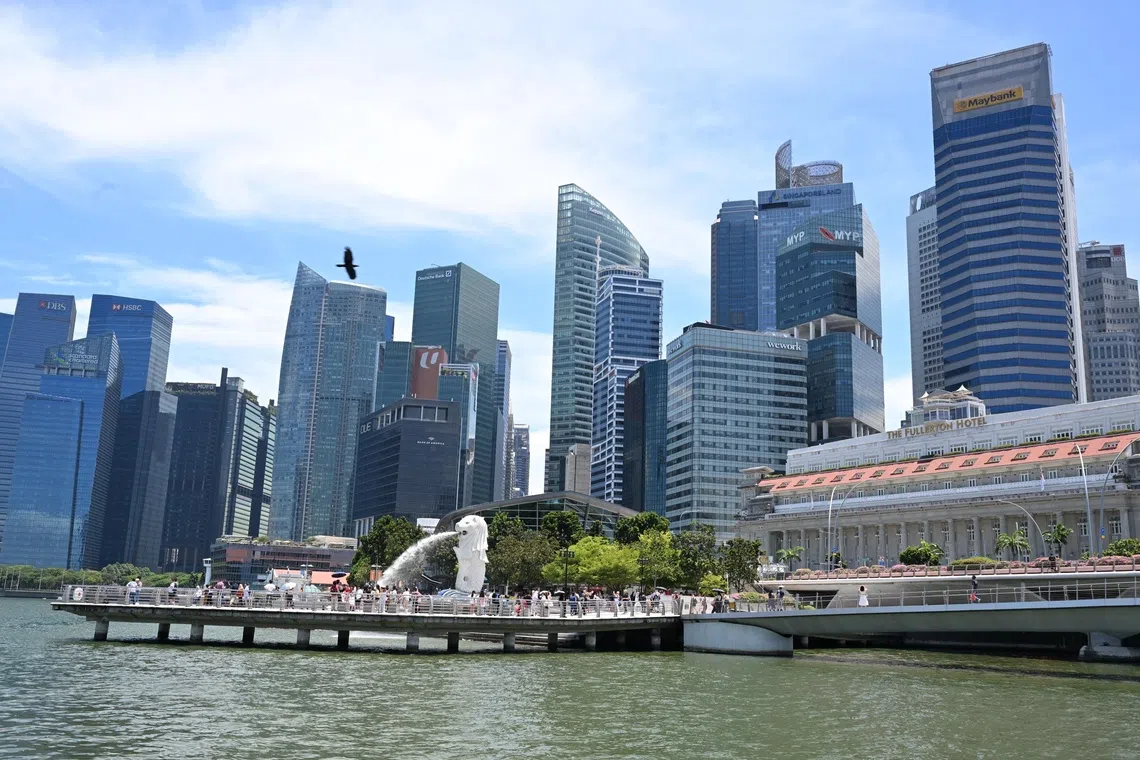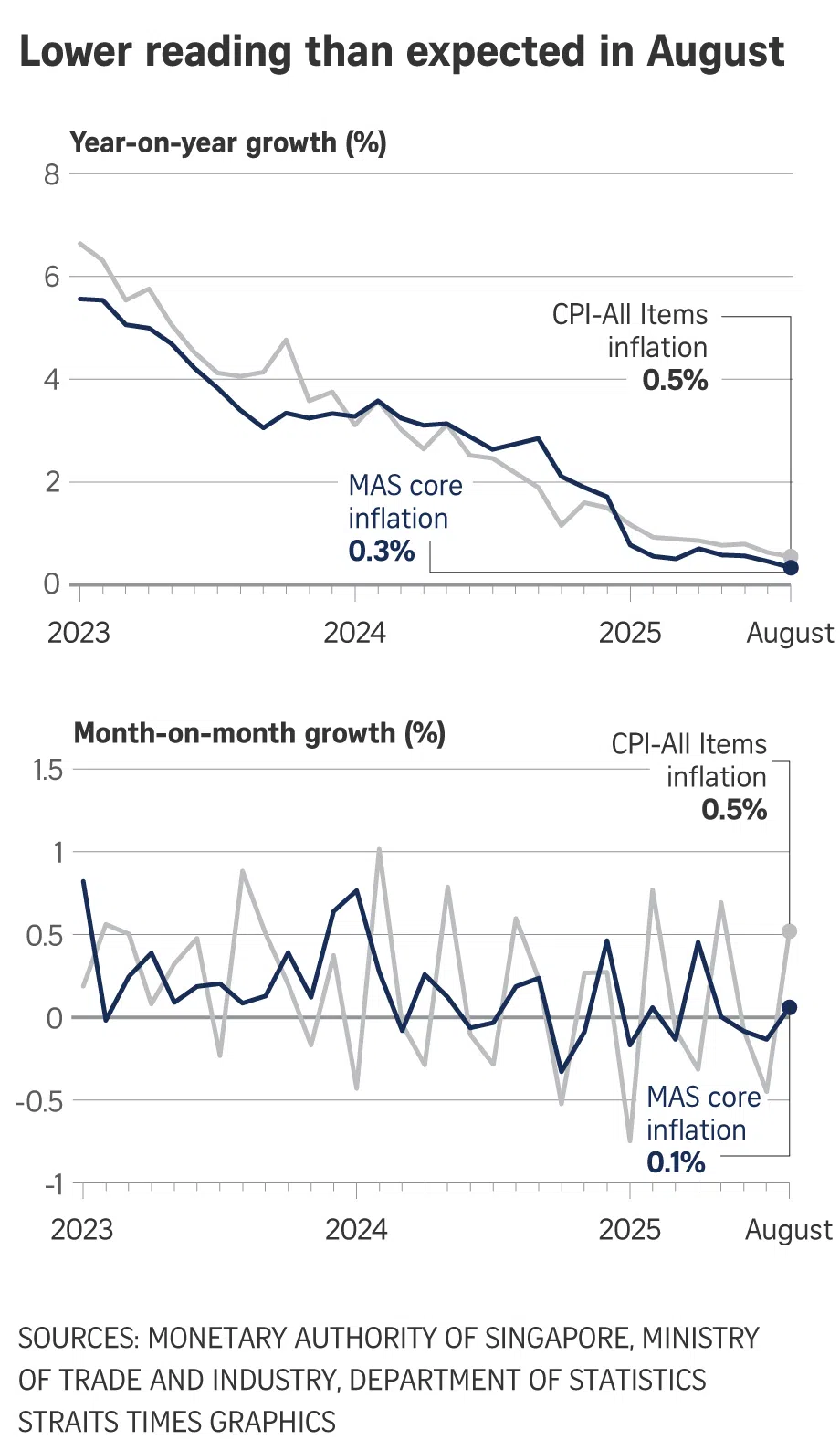Singapore core inflation drops more than expected to 0.3% in August; lowest in over 4 years
Sign up now: Get ST's newsletters delivered to your inbox

Services inflation slowed to 0.4 per cent, from 0.7 per cent in July, amid a steeper decline in the costs of holiday expenses, airfares and inpatient services.
ST PHOTO: CHONG JUN LIANG
Follow topic:
- Singapore's core inflation fell to 0.3% in August, the lowest since February 2021, lower than economists' 0.5% forecast.
- The drop in core inflation was largely due to slower services inflation at 0.4%, driven by declining holiday expenses and airfares and lower electricity/gas costs.
- MAS and MTI maintain 2025 inflation forecasts at 0.5% to 1.5%, expecting moderate imported inflation and government subsidies to dampen services inflation.
AI generated
SINGAPORE – Consumer price pressures in Singapore eased more than expected in August, with year-on-year core inflation falling to its lowest since February 2021.
While economic uncertainty and government subsidies have lowered inflation, some economists expect inflation to rise from the fourth quarter of 2025, given factors such as rising certificate of entitlement (COE) premiums and falling interest rates.
In August, core inflation dropped for the second month in a row to 0.3 per cent year on year, from 0.5 per cent in July, the Monetary Authority of Singapore (MAS) and Ministry of Trade and Industry (MTI) said in their joint report on Sept 23.
The reading came in lower than the 0.5 per cent forecast by economists in a Bloomberg survey.
Core inflation excludes private transport and accommodation costs to better reflect the expenses of households here.
Overall – or headline – inflation was 0.5 per cent, down from 0.6 per cent in July, owing to lower accommodation inflation and core inflation. The economists polled had forecast no change in the gauge.
MAS and MTI said Singapore’s imported inflation should remain moderate in the near term as inflationary effects from ongoing trade conflicts are likely to be offset by weaker global demand.
“Global crude oil prices remain below year-ago levels, while food commodity price increases should also stay contained. On the domestic front, slower nominal wage growth and continuing increases in labour productivity should contribute to a moderation in unit labour costs,” they said.
“At the same time, enhanced government subsidies for essential services will continue to dampen services inflation.”
MAS and MTI stuck to their forecasts that core and overall inflation will average 0.5 per cent to 1.5 per cent in 2025.
DBS Bank senior economist Chua Han Teng said low inflation in 2025 marks significant relief from the elevated price increases of the past few years, amid an uncertain and volatile economic landscape that could bring potential job disruptions.
“The pass-through of business costs to consumer prices has stayed contained due to moderate domestic labour cost pressures amid restrained wage increments given elevated economic uncertainty,” he said.
He added that government subsidies have also helped to contain essential services inflation.
Maybank economists Chua Hak Bin and Brian Lee said the downward pressure on core inflation in recent months stemmed mostly from external factors and domestic subsidies, rather than weakening demand.
“Consumer demand remains resilient despite economic uncertainty, cushioned by optimism from the rising stock market and property prices, as well as the Government’s CDC vouchers and other cost-of-living support,” they said.
OCBC Bank’s chief economist Selena Ling, however, said CDC vouchers are likely to mitigate or offset the larger expected cooling in domestic demand rather than affect inflation directly.
She noted that the current low inflation situation points to a modest pullback in demand conditions given the softening in the local labour market and external headwinds, such as tariffs and the growth slowdown in major economies like the United States and China.
“This will also weigh on business confidence and indirectly affect businesses’ ability to raise prices to end-consumers,” she said.
“There is likely another factor, which is that US tariffs may be contributing to a rerouting of Chinese exports away from the US and an influx into the rest of the world including Singapore, so the increased competition drives prices lower.”
Ms Ling added that core and headline inflation may edge higher in the fourth quarter, reversing the third quarter’s weak inflation numbers.
“That said, there is some downside risk, so I will shade down slightly my 2025 headline and core consumer price index forecasts to 0.8 per cent and 0.6 per cent year on year, respectively.”
Mr Chua and Mr Lee of Maybank raised their inflation forecasts for 2026, projecting headline inflation at 1.2 per cent, from 0.9 per cent, and core inflation at 1.1 per cent, from 0.8 per cent.
They cited factors such as rising COE premiums, the reduction of the maximum Vehicular Emissions Scheme rebate for electric vehicles, and hybrid vehicles no longer qualifying for such rebates from 2026.
They added that monetary easing and falling interest rates, with their downward pressure on the Singapore dollar, could also fan price pressures in 2026.
MAS and MTI said August’s drop in core inflation was due mainly to a moderation in services inflation, which slowed to 0.4 per cent, from 0.7 per cent in July. This came amid a steeper decline in the costs of holiday expenses, airfares and inpatient services.
Electricity and gas costs fell at a slightly quicker pace of 5.7 per cent, owing to a larger decline in electricity prices. Accommodation inflation eased to 0.4 per cent, from 0.5 per cent in July, owing to a smaller increase in housing rents.

Prices of retail and other goods fell at a slower pace of 0.2 per cent, after falling 0.5 per cent in July, as prices of clothing and footwear rose, while those of telecommunications equipment registered a smaller decline.
Private transport inflation rose to 2.4 per cent, from 2.1 per cent in July, on the back of a larger increase in car prices, as well as a smaller decline in petrol prices. Food inflation was unchanged at 1.1 per cent, as a slight moderation in non-cooked food inflation was offset by a mild pickup in food services inflation.

